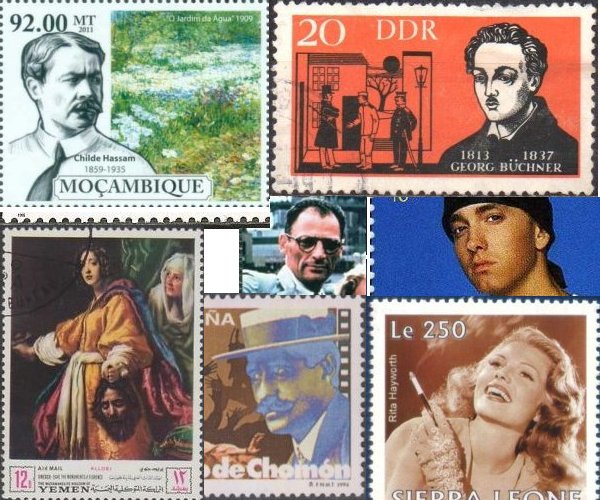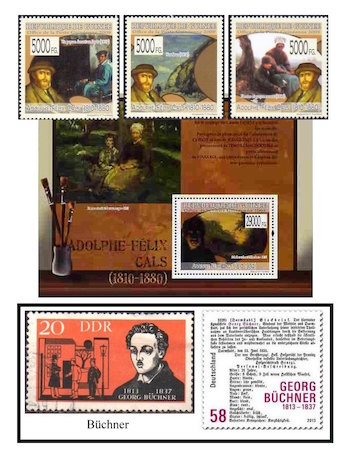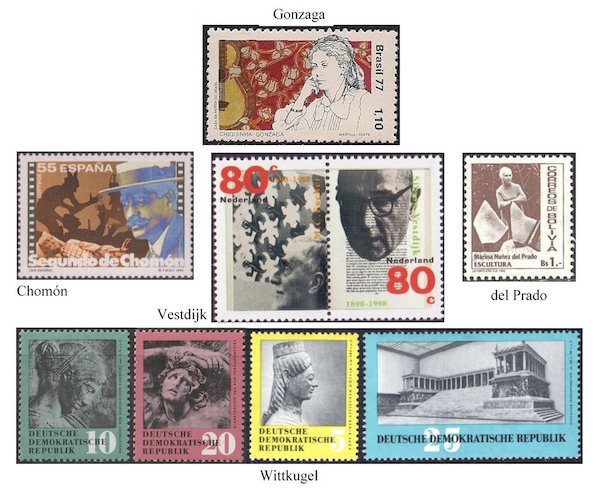The Arts on Stamps of the World —October 17
An Arts Fuse regular feature: the arts on stamps of the world.

By Doug Briscoe
Today’s headliners are both Americans, the painter Childe Hassam and the playwright Arthur Miller.
A great favorite among art lovers today, Childe Hassam (October 17, 1859 – August 27, 1935) hailed from Dorchester. His family had been in New England for a long time and was even distantly related to Nathaniel Hawthorne. Hassam’s (accent on the first syllable) long professional career began with illustrations for the prominent magazines and in sum saw the production of 3,000 pieces. In this selection from stamp sheets of Mozambique, Ghana, Togo, the Solomon Islands, and the Central African Republic, we see, in the top row, Water Garden (1909), one of Hassam’s many flag paintings, Flags on the Friar’s Club (1918), Isle of Shoals (1902), and Brittany Peasant at the Pardon (1897) and, in the bottom row, Fifth Avenue (1918), April (aka The Green Gown, 1920), and La Val-de-Grâce, Spring Morning (1888).
To face facts, Arthur Miller (October 17, 1915 – February 10, 2005) is for the present on a stamp only because he was married to Marilyn Monroe, an extremely popular topic for postage stamps from around the world. Miller was born in Manhattan and wrote his first play, No Villain (1936), while working as a young journalist. His first play to be produced was The Man Who Had All the Luck (1940), which won the Theater Guild’s National Award despite receiving poor reviews and closing after four performances. Seven years later he won a Tony for All My Sons (1947). Death of a Salesman dates from the next year and was the first play to win a Tony, the New York Drama Circle Critics’ Award, and the Pulitzer Prize. His daughter Rebecca from Miller’s third marriage (to photographer Inge Morath) has been married to Daniel Day-Lewis since 1996.

We turn back to painting for our next four consecutive subjects. Florentine artist Cristofano Allori (17 October 1577 – 1 April 1621) made copies of works by Correggio that for a long time were thought to have been executed by Correggio himself. The Cuban stamp shows a portrait of a member of the Medici family. I’m guessing this is Francesco de’ Medici (1594-1614), son of Grand Duke Ferdinand I and younger brother of Cosimo II. As small children, Francesco and his sister Caterina had previously been captured in an another portrait (1596) by Allori. On the stamp fromYemen is Allori’s most famous work, in his own lifetime and today, Judith with the Head of Holofernes (1613).
Note that I said we’d be turning to “painting” for four subjects in a row. That was a tad misleading, on account of our next artist being a writer, but his only stamp is one depicting him in an historical painting by Walter William Ouless. I refer to Jacques Cazotte (1719 – 25 September 1792), a member of the French Ministry of the Marine who turned to writing only around 1760. He wrote a mock romance and a bawdy song that caught on and led him to attempt more projects, plays, fantastic tales, the most popular of which was Le Diable amoureux (The Devil in Love, 1772), verse, and translations. He became a mystic, declaring he had the power of prognostication. As a consequence of the discovery of some of his counter-revolutionary correspondence, he was guillotined, and it is this sad fate that caught the imagination of Ouless some eighty years later.
The painter Leopold Kupelwieser (1796 – 17 November 1862) is represented on a bicentennial stamp from his native Austria based on the artist’s Self-Portrait (c1813). A gifted child, Kupelwieser was already attending the Academy of Fine Arts in Vienna by the age of 12. After a period in Rome, he returned to Vienna and became a member of Franz Schubert‘s circle of friends. Schubert wrote—or rather, played—a nuptial dance for him, the “Kupelwieser Waltz”, which, it seems, was never actually written down, but was passed along by ear within the family for more than a century until transcribed by Richard Strauss in 1943! Kuperlwieser’s earlier work consists mainly of illustrations and portraits, in later years altarpieces and frescoes. His brother Josef, a theatrical director, wrote the libretto for Schubert’s opera Fierrabras.

The only stamps I could find for the French portrait, genre, and landscape painter Adolphe-Félix Cals (17 October 1810 – 3 October 1880) come from a pair of souvenir sheets from the Republic of Guinea. From these I have extracted A Peasant in Front of a Hearth, Honfleur (1874), Peasant Woman and Child (1846), Woman and Child in an Orchard, and Sundown at Honfleur (1875). Cals was born in poverty, but in an unusual break from tradition, his thoughtful parents desired to keep him from a hard life of drudgery and apprenticed him to an engraver. Artistic success eluded him until late in life.
A remarkably forward-looking writer, the young genius Georg Büchner (17 October 1813 – 19 February 1837) produced in his brief life a small but highly regarded body of work, most notably the play Woyzeck (1837), which formed the basis for Berg‘s opera (Wozzeck, 1925) and Werner Herzog’s 1979 film. Büchner became interested in politics at 15 and at the same age joined a Shakespeare circle. He studied medicine and became a revolutionary, producing in 1834 a leaflet addressing social injustice. The authorities issued a warrant for his arrest (seen on the bicentenary stamp of 2013), and his colleague, brutalized, died in prison, but Büchner escaped and ended up as an anatomy lecturer in Zurich. Tragically, he died of typhus at 23. In addition to his own prose and verse, Büchner also translated two Victor Hugo plays. A Georg Büchner Prize, Germany’s most prestigious literary award, has been awarded annually since its creation in 1923.
October 17 is the birthday of Brazilian composer Chiquinha Gonzaga (1847 – February 28, 1935). Born Francisca Edwiges Neves Gonzaga, she entered into an arranged marriage at 16 with a wealthy navy official who prohibited her from following a musical career. He was also abusive, and she left him when she was 20, supporting herself and her three children by teaching piano, her father having disowned her. According to Wikipedia, she was the very first woman in Brazil to obtain a legal divorce. Her first success as a composer was with the polka “Atraente” (1877), and she went on to write some 300 pieces, most of them in various dance forms. But there were also 77 works for the stage, among them the three-act operetta Forrobodó (1912), which received 1500 performances. Although much criticized by the male-dominated society of her time, she was also active politically, working for the end of slavery in Brazil (1888) and the proclamation of the Republic (1889). Her most recorded tune is the tango “Gaúcho” or “Corta Jaca” from the operetta Zizinha Maxixe (1895).

One of the earliest of filmmakers was the Spaniard Segundo de Chomón (also Chomont or Chaumont; 1871 – 2 May 1929). He started out in distribution and PR for Pathé Brothers and within a short time was making his own films. Like Méliès, he soon began experimenting with trick photography, producing Gulliver in the Land of the Giants in 1903. Pathé himself liked these efforts and, wanting to compete with Méliès, moved the operation from Barcelona to Paris. Later on, Chomón contributed special effects to films by other directors, including Abel Gance’s magnificent Napoléon (1927). (Gance’s birthday is next week.)
Another writer who was a medical student (like Büchner) was Simon Vestdijk (17 October 1898 – 23 March 1971), held as one of the most important of 20th-century Dutch writers. He practiced medicine briefly, including a stint on a ship, before devoting himself to literature. He wrote a staggering number of books—52 novels, most of them falling into the categories of psychological, autobiographical, historical, historical-pastoral—200 all told. In addition, there are poems and short stories, and Vestdijk was also a prolific essayist, especially on literature, religion, art, and music.
A central figure in East German commercial and poster art, Klaus Wittkugel (17 October 1910 – 19 September 1985) was also significant as a stamp designer (and overseer) for the German Democratic Republic. Among his philatelic designs are those for a series about the return of antiquities that had been confiscated by the Soviet Union after the war. He had a hand, too, in some of the designs for stamps we’ve already seen here on AoSotW, those for art works by Otto Nagel and Käthe Kollwitz, and we’ll see more of these in the months to come.
Bolivian sculptor Marina Núñez del Prado (1910 – 9 September 1995), born in La Paz, is one of most respected sculptors from anywhere in Latin America. Her work in general has had two primary sources of inspiration: Michelangelo and the indigenous cultures of Bolivia. She studied at the Academy of Fine Arts in La Paz, where later she taught and eventually became the first woman chair. At one point she lived in New York for eight years. Del Prado spent the final 23 years of her life in Peru with her husband, the writer Jorge Falcón. Two of her most celebrated pieces, both fashioned in white onyx, are White Venus (1960) and Mother and Child. The indigenous influence is more fully on display in Danza de cholos (1938).

The writer half of the creative team that came up with Superman was Cleveland-born Jerry Siegel (1914 – January 28, 1996), the art man being Joe Shuster. The pair shopped the idea around for four years before it appeared in the first issue of Action Comics in 1938. Given that we already saw the US Superman issues (three of them!) in our piece on Shuster, I thought we’d share today a strip of five Superman stamps from Canada.
I always thought Betty Grable was the top pin-up girl for GIs during World War II, but no, that distinction belongs to Rita Hayworth, whose centenary is coming up next year (October 17, 1918 – May 14, 1987). She was born in Brooklyn as Margarita Carmen Cansino to a father from Spain and an American mother of Anglo-Irish descent. Her father wanted her to be be a dancer, her mother hoped she’d be an actress; in the event, she became both. In her first fifteen or so films, she was credited as Rita Cansino and tended to be typecast as an “exotic” foreigner until she changed her stage name to Rita Hayworth in 1937. She was in a goodly number of successful pictures. Fred Astaire said she was his favorite dance partner. Rita Hayworth died of early onset Alzheimer’s at a time when the disease received little public attention. Her case helped change that.
Knowing nothing about rap music, I have assumed that Eminem, who turns 45 today, was a successful but not really central figure in the genre. Now I discover that he is today’s best-selling hip-hop performer. Born Marshall Bruce Mathers III in St. Joseph, Missouri, he appears in an unofficial stamp set issued by Somalia in 2004.
Also born on this day, but still stampless, is the great American writer Nathanael West (born Nathan Weinstein; October 17, 1903 – December 22, 1940).
A graduate of the University of Massachusetts with a B.A. in English, Doug Briscoe worked in Boston classical music radio, at WCRB, WGBH, and WBUR, for about 25 years, beginning in 1977. He has the curious distinction of having succeeded Robert J. Lurtsema twice, first as host of WGBH’s weekday morning classical music program in 1993, then as host of the weekend program when Robert J.’s health failed in 2000. Doug also wrote liner notes for several of the late Gunther Schuller’s GM Recordings releases as well as program notes for the Boston Classical Orchestra. For the past few years he’s been posting a Facebook “blog” of classical music on stamps of the world, which has now been expanded to encompass all the arts for The Arts Fuse.

